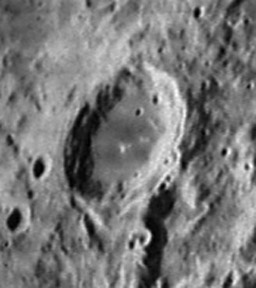Difference between revisions of "Mercurius"
| Line 14: | Line 14: | ||
<br /> | <br /> | ||
==Description: Elger== | ==Description: Elger== | ||
| − | ''([[IAU% | + | ''([[IAU%20directions|IAU Directions]])'' MERCURIUS.--This formation is 25 miles in diameter. A small crater stands on the S.W. section of the wall. There is a longitudinal range in the interior, and on the E. and N.E. the remains of two large walled-plains, the more easterly of which is a noteworthy object under suitable conditions. A short distance S. is a large, irregular, and very dark marking. On the N., lies an immense bright plain, extending nearly to the border of [[Endymion|Endymion]].<br /> <br /> |
==Description: Wikipedia== | ==Description: Wikipedia== | ||
[http://en.wikipedia.org/wiki/Mercurius_(crater) Mercurius]<br /> <br /> | [http://en.wikipedia.org/wiki/Mercurius_(crater) Mercurius]<br /> <br /> | ||
==Additional Information== | ==Additional Information== | ||
| − | Depth data from [[Kurt%20Fisher% | + | Depth data from [[Kurt%20Fisher%20Crater%20Depths|Kurt Fisher database]]<br /> |
* Westfall, 2000: 3.6 km | * Westfall, 2000: 3.6 km | ||
* Cherrington, 1969: 2.98 km | * Cherrington, 1969: 2.98 km | ||
Latest revision as of 02:04, 16 April 2018
Contents
- 1 Mercurius
- 1.1 Images
- 1.2 Maps
- 1.3 Description
- 1.4 Description: Elger
- 1.5 Description: Wikipedia
- 1.6 Additional Information
- 1.7 The ESE-WNW tendency of the region surrounding Mercurius
- 1.8 Other indications of the ESE-WNW tendency in the region of Mercurius
- 1.9 Nomenclature
- 1.10 LPOD Articles
- 1.11 Bibliography
Mercurius
|
Lat: 46.6°N, Long: 66.2°E, Diam: 67 km, Depth: 3.6 km, Rükl 15, Nectarian |
Images
LPOD Photo Gallery Lunar Orbiter Images Apollo Images
Maps
(LAC zone 28A2) USGS Digital Atlas PDF
Description
Description: Elger
(IAU Directions) MERCURIUS.--This formation is 25 miles in diameter. A small crater stands on the S.W. section of the wall. There is a longitudinal range in the interior, and on the E. and N.E. the remains of two large walled-plains, the more easterly of which is a noteworthy object under suitable conditions. A short distance S. is a large, irregular, and very dark marking. On the N., lies an immense bright plain, extending nearly to the border of Endymion.
Description: Wikipedia
Additional Information
Depth data from Kurt Fisher database
- Westfall, 2000: 3.6 km
- Cherrington, 1969: 2.98 km
The ESE-WNW tendency of the region surrounding Mercurius
An investigation of the online WAC-mosaic in the LROC ACT-REACT QUICK MAP reveals a certain tendency of east-southeast to west-northwest arranged formations running all over the region of Mercurius and its surroundings. Even on the floor of Mercurius itself there are two elongated hills with the same ESE-WNW tendency. There is also a rather long ESE-WNW arranged "valley" which runs all the way from Mercurius J (west of Mercurius itself) to Zeno A (east-southeast of Mercurius). The central section of this long valley is touching the southern part of Mercurius' rim.
Other indications of the ESE-WNW tendency in the region of Mercurius
The two "valleys" east and west of Endymion D
The "valley" northwest of Messala C (south of Lacus Spei)
The "valley" east of Messala J
The section of Zeno's rim between Zeno and Zeno D west of it
The "valley" east-southeast of Zeno E
The elongated crater southeast of Zeno X
Nomenclature
- The IAU name is the Latin spelling for mythological figure, Mercury.
- The name was given by Riccioli, although Whitaker feels that the feature so-labeled was the modern Lacus Spei, and that the modern Mercurius was called Osymandies by Riccioli (pp. 213-214). Due to the ambiguities in the rendering of the limb areas of Riccioli's map, it is difficult to verify this.
- Riccioli's name Mercurius became more definitely attached to the present feature when Lichtenberg prepared the nomenclature index to accompany Tobias Mayer's published map. As reworked for Johann Schröter's book, the list also includes a Mercurius falsus attributed, there, to Riccioli but possibly an invention of Schröter or Lichtenberg. Mercurius falsus appears to be the modern Gauss.
- Mercurius, by then agreed to by all authorities as the proper name for the present feature, became Catalog Entry 396 in the Collated List and in Named Lunar Formations.
LPOD Articles
Bibliography
